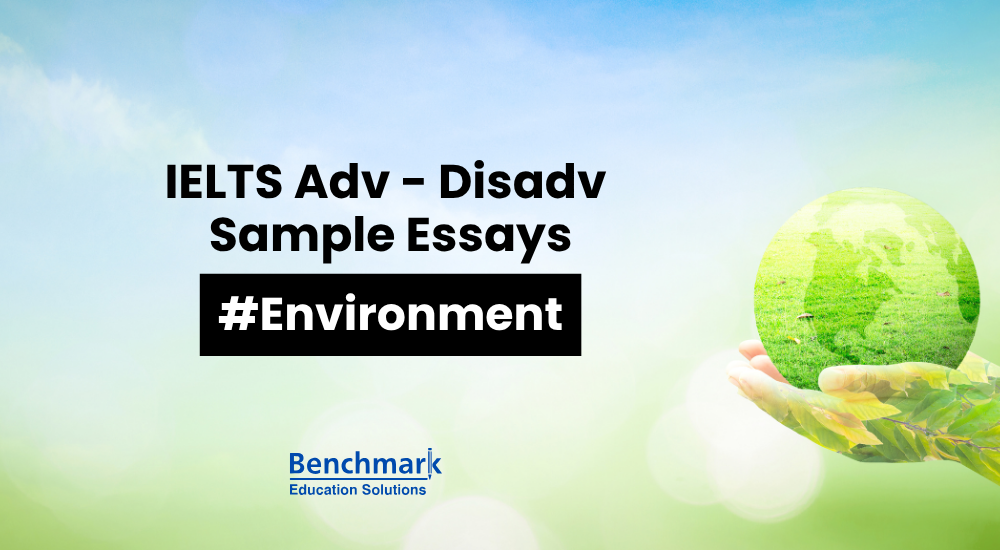IELTS Advantage and Disadvantage Essay: Environment Topics with Sample Answers
- 0 Comments


In the Academic IELTS Writing section, environment-related essay topics often focus on global environmental issues and sustainable solutions. Common subtopics might include: the impact of climate change, the role of renewable energy, deforestation and its effects, the importance of wildlife conservation, pollution and its control, and the responsibility of governments versus individuals in protecting the environment.
Find useful IELTS vocabulary on the environment here.
Use Benchmark IELTS Writing Correction service to write error-free IELTS Essays, Letters & Reports.
Essay Topics
Task 1
With the increasing demand for energy sources of oil and gas, people should look for sources of oil and gas in remote and untouched natural places. Do the advantages outweigh the disadvantages of damaging such areas?
How to Approach the Essay:
Approach: This is an “advantages vs. disadvantages” + opinion essay. Start by identifying the key issue: whether the benefits of exploring oil and gas in untouched areas are worth the environmental cost.
Structure:
| Arguments in Favor of Resource Extraction | Arguments Against Resource Extraction |
|---|---|
| • Fossil fuels are essential for transportation, food production, and energy • Contributes to economic growth through job creation and infrastructure development • Improves living standards, especially in resource- dependent regions | Degrades natural habitats with severe ecological consequences • Destroys biodiversity and risks extinction of species • Threatens climate regulation and global oxygen production (e.g., Amazon rainforest) |
Model Answer
There are ongoing contentious debates regarding the desirability of exploiting pristine natural environments for the extraction of oil and gas. While some may argue in favor of such endeavors, I firmly believe that the disadvantages of going into these untouched areas far outweigh any potential benefits. In this essay, I will discuss both perspectives before presenting my viewpoint.
On one hand, proponents of resource extraction in remote areas argue that tapping into fossil fuels is essential for sustaining modern life. For instance, fossil fuels are integral to various aspects of daily living, including transportation, food production, and energy generation. They also say that resource extraction can contribute to economic growth, and that revenues generated from fossil fuel extraction often lead to job creation, improved infrastructure, and enhanced living standards, particularly in regions that rely heavily on these industries.
However, many argue that the exploitation of pristine environments carries substantial drawbacks. Firstly, the degradation of natural habitats can lead to severe ecological consequences. For example, if the Amazon rainforest is subjected to resource extraction, its vital role in producing oxygen and regulating the Earth’s climate would be compromised, ultimately jeopardizing human health. Furthermore, the pursuit of fossil fuels in these areas often results in a significant loss of biodiversity. As habitats are destroyed, countless species of flora and fauna face extinction. A poignant illustration of this is the alarming decline of various animal species in Canadian forests, which have been devastated by human activities aimed at extracting oil from tar sands.
In conclusion, the arguments against the destruction of pristine natural environments for oil and gas extraction are far more compelling than those in favor. The potential harm to ecosystems, biodiversity, and ultimately human well-being underscores the need for a more sustainable approach to energy sourcing.
Commentary
Essay Question: Do the advantages outweigh the disadvantages of damaging such areas?
Introduction
- Clarity: The introduction clearly presents the topic and the writer’s stance.
- Thesis Statement: Effectively states the belief that disadvantages outweigh advantages.
Body Paragraphs
Main Arguments/Examples:
- Pro Development: Fossil fuels are essential for daily life (transportation, food production) and economic prosperity.
- Con Development: Environmental degradation, loss of biodiversity, and health risks.
- Argument Balance: The essay presents a balanced view by discussing both sides before concluding with a strong opinion.
- Coherence and Cohesion: Logical flow is maintained through clear transitions and structured paragraphs.
Conclusion
- Effectiveness: Summarizes the main points and reinforces the opinion that disadvantages outweigh advantages.
Useful Vocabulary, Phrases, and Complex Structures
High-Level Vocabulary Words:
- “Contentious” (causing or likely to cause an argument),
- “Pristine” (in its original condition; unspoiled),
- “Sustainable” (able to be maintained at a certain rate),
- “Biodiversity” (the variety of life in the world or a particular habitat).
Useful Academic Phrases:
- “However many argue that…”
- “A poignant illustration of this is…”
Complex Sentence Examples:
- “As habitats are destroyed, countless species of flora and fauna face extinction.”
- “While some may argue in favor of such endeavors, I firmly believe that the disadvantages far outweigh any potential benefits.”
Task 2
In order to solve traffic problems, governments should tax private car owners heavily and use the money to improve public transportation. What are the advantages and disadvantages of such a solution? Give reasons for your answer and include any relevant examples from your own experience or knowledge. Write at least 250 words.
How to Approach the Essay:
Approach: This is an “advantages and disadvantages” question asking you to evaluate a specific government policy—taxing private car owners to fund public transport. Begin by identifying the core idea: reducing traffic via taxation and investment in transit.
Structure:
| Advantages of Taxing Private Car Owners | Disadvantages of Taxing Private Car Owners |
|---|---|
| • Encourages public transport use, reducing traffic congestion • Saves commuting time through efficient transit systems • Reduces carbon emissions and improves air quality | • Restricts mobility, especially for rural and remote residents • May be seen as unfair by those with no transport alternatives • Public transport upgrades may not benefit all socioeconomic groups equally |
Model Answer
It is becoming increasingly common for governments to impose substantial taxes on private car owners to address traffic congestion, using the revenue to enhance public transportation systems. This essay will examine the advantages and disadvantages of such a policy.
One of the most significant advantages is that it encourages individuals to utilize public transportation, leading to increased time efficiency. This is because a well-developed public transportation system can significantly reduce traffic jams, saving commuters time. Moreover, this solution has the potential to decrease carbon dioxide emissions produced by vehicle exhausts. Research has shown that developed countries tend to enjoy cleaner air quality compared to developing nations, largely due to effective strategies to mitigate traffic-related issues.
However, imposing heavy taxes on car owners also presents notable disadvantages, the most significant being the restriction of mobility. Many individuals, particularly those residing in rural areas or working in remote locations, have limited transportation alternatives and rely solely on their vehicles to reach their destinations. So, imposing a heavy tax on these people may be perceived as unjust. Furthermore, while improving public transportation is a commendable goal, it may not effectively resolve traffic problems due to the disparities in affordability among different socioeconomic groups. As a result, those who feel marginalized may develop a sense of frustration and discontent towards their government.
In conclusion, while the potential benefits of increased efficiency and environmental sustainability through such a tax policy are noteworthy, the drawbacks related to fairness and economic accessibility must also be carefully considered. No one should feel left behind or suffer unjustly because of transportation measures.
Commentary
Essay Question:
- The essay addresses the question by discussing both advantages and disadvantages of taxing private car owners to improve public transportation.
Introduction
- The introduction clearly states the topic and presents a strong thesis statement outlining the essay’s focus on both benefits and drawbacks.
Body Paragraphs
Main Arguments/Examples:
- Advantages: Encouragement of public transportation use, time efficiency, reduction in carbon emissions, cleaner air quality in developed countries.
- Disadvantages: Restriction of mobility for rural residents, perceived unfairness of the tax, potential ineffectiveness due to socioeconomic disparities.
- The arguments are balanced, with clear transitions enhancing coherence and cohesion throughout the essay.
Conclusion
- The conclusion effectively summarizes the main points and reinforces the need to consider both the benefits and drawbacks of the proposed solution.
Useful Vocabulary, Phrases, and Complex Structures
High-Level Vocabulary Words:
- Substantial (considerable in quantity)
- Mobility (the ability to move freely)
- Disparities (inequalities)
- Marginalized (treated as insignificant)
- Commendable (worthy of praise)
- Sustainability (the ability to be maintained)
Useful Academic Phrases:
- “This essay will examine…”
- “One of the most significant advantages…”
- “However, imposing heavy taxes…”
- “As a result, those who feel marginalized…”
- “In conclusion, while the potential benefits…”
Complex Sentence Examples:
- ” Research has shown that developed countries tend to enjoy cleaner air quality compared to developing nations, largely due to effective strategies to mitigate traffic-related issues.”
- “So, imposing a heavy tax on these users may be perceived as unjust.”
More Articles
IELTS Advantage and Disadvantage Essay: Tourism Topics with Sample Answers
Explore IELTS Writing Task 2 advantage and disadvantage essays on tourism-related topics such as international travel, cultural impact, and environmental concerns. Includes sample answers and vocabulary tips.
IELTS Advantage and Disadvantage Essay Topics: Technology Sample Answers
Master IELTS Writing Task 2 with sample advantage and disadvantage essays on technology-related topics like e-books vs paper books and online shopping. Improve structure, vocabulary, and coherence.
IELTS Advantage and Disadvantage Essay: Employment Topics and Model Answers
Learn how to write IELTS advantage and disadvantage essays on employment topics like remote work, automation, and job security. Includes sample answers and writing tips for high scores.
IELTS Advantage Disadvantage Essay on Economy – Sample Answer & Tips
Explore IELTS Writing Task 2 advantage and disadvantage essays on economic topics. Learn how to write about globalization, economic growth, and government spending with balanced arguments and strong structure.












